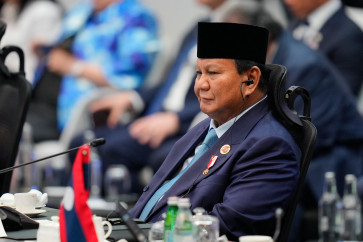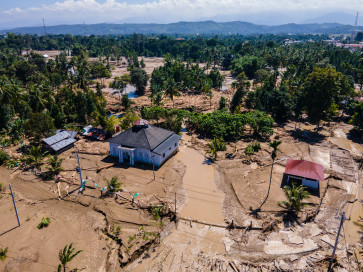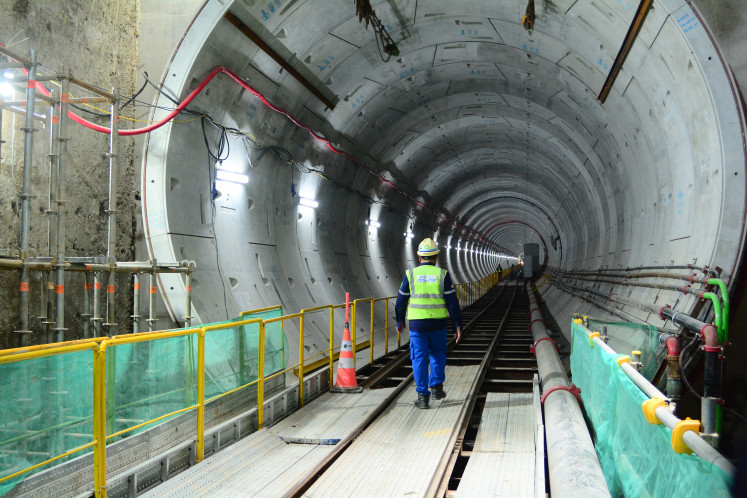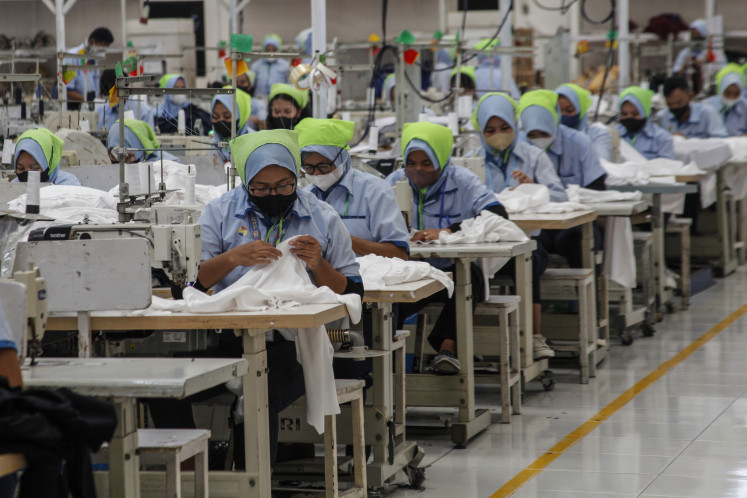Popular Reads
Top Results
Can't find what you're looking for?
View all search resultsPopular Reads
Top Results
Can't find what you're looking for?
View all search resultsConsumption keeps growing as energy infrastructure worsens
While domestic demand for oil is escalating uncontrollably (12 percent for gasoline and 15 percent for diesel fuel in 2007) and domestic oil production has been on a continuous slide for the last 13 years, it is sad to find that oil prices are skyrocketing and our energy infrastructure is deteriorating
Change text size
Gift Premium Articles
to Anyone
While domestic demand for oil is escalating uncontrollably (12 percent for gasoline and 15 percent for diesel fuel in 2007) and domestic oil production has been on a continuous slide for the last 13 years, it is sad to find that oil prices are skyrocketing and our energy infrastructure is deteriorating. What will happen next?
Oil refinery capacity in Indonesia has not expanded since Balongan EXOR (West Java) started operating in the mid 1990s. The total capacity is stuck at 1.055 million bpd, even decreasing since Pangkalan Brandan was shut down recently.
Except EXOR, all the refineries are old, most of them having started operation before the 1980s (Sei Pakning in 1957, Plaju in 1930 by Shell). Four out of nine refineries (about one-third of national capacity) are located in Sumatra, far from the middle and eastern islanders who also need oil.
Geographical constraints, old technology and capacity does not fit the changing domestic demand, resulting in the increasing cost of importing fuels.
Infrastructure for distributing oil across the archipelago is also decaying. There has been no significant development except in gasoline stations, which currently number about 3,000.
A middle-high pressure pipeline for oil products is still very limited and has not been expanded for the last three decades. The country's 170 oil storage sites are not sufficient, but the progress to build new sites has been very slow.
Nevertheless, infrastructure for distributing oil in western parts of Java is sufficient; oil fuel in this region is transported efficiently through a transmission pipeline from Cilacap refinery (Central Java) to demand centers close to Bandung/Jakarta.
But for the rest of the country, even in other parts of Java -- the island consuming three-fourths of the country's fuel -- the oil distribution system is far from efficient. There is no refinery or oil distribution pipeline operating in East Java. A distribution system relying on trucks, train, ships, barges and small aircraft in the country's remote areas results in very expensive transportation costs.
Indonesia's energy consumption will continue to grow in line with the growth of the country's economy, urban population and changes in lifestyle that consume more energy. This trend of energy consumption will continue to take place despite rising oil prices.
Energy demand does not have to be fulfilled by oil alone, as it can be replaced by other fuels such as natural gas for electricity generation, industry, households and transportation. Coal may substitute for oil, particularly in electricity generation and the industrial sector, while coal briquette can replace kerosene for cooking. Natural gas is cheaper, cleaner and more efficient than oil and Indonesia has larger reserves of natural gas than of oil.
Unfortunately, our capacity to switch from oil to natural gas is very small, constrained largely by the availability of infrastructure.
Only the South Sumatra-West Java natural gas transmission pipeline is ready to operate, brining natural gas from Jambi (southern Sumatra) to Banten's industrial estates and further to power plants near Jakarta.
Large parts of our gas are still exported by pipeline to Singapore and Malaysia, and to Japan, South Korea and Taiwan as LNG. Combined cycle power plants in Java, constructed under a crash program during the 1990s, are still facing difficulties in getting natural gas delivered to them, forcing the plants to burn expensive oil.
The development of city gas distribution systems faltered in the 1990s, leaving only about 75,000 households receiving gas deliveries. Below 1 percent of all households in Indonesia rely on natural gas, far lower than in the United States, major European countries or even Japan and Korea, whose gas consumption depends on LNG imports from Indonesia.
Recently, there was an attempt to move people over from using kerosene to LPG. LPG may substitute for kerosene for cooking, but the benefits of this switch will not go far since our LPG production capacity (coming from oil, small LPG and LNG refineries) is limited and the price of LPG is expensive (compared to that of natural gas). LPG technology is not intended to provide energy for a large number of households; piped city gas normally does this job.
Coal provision faces similar obstacles. Compared to for export -- Indonesia became the world's largest exporter of coal three years ago -- the infrastructure needed to deliver coal to the domestic market is very limited.
This could derail prospects for the government's ambition plan to build coal-fired plants with a combined capacity of 10,000 MW.
Following the New Order regime, the implementation of a 2001 law on oil and gas and other laws on regional autonomy and business competition, as well as the annulment of the 2002 law on the electricity industry by the Constitutional Court, have done nothing to improve energy security. The implementation the 2001 law on oil and gas has not resulted in the development of any new downstream infrastructure.
The master plan for the national gas transmission and distribution network was officially released by the government in 2005, but so far there has been no new transmission pipelines or distribution areas built in accordance with the master plan.
A national master plan for oil downstream infrastructure (refineries, storage sites, transmission and distribution) has not been released.
It is not clear now who should be responsible for the development of the country's energy infrastructure. The government, which for too long relied on state companies (Pertamina, PGN, PLN) for the provision of energy infrastructure, seems ill prepared to perform the task as an effective regulator.
State-owned oil and gas company Pertamina does not prioritize development of downstream oil and gas infrastructure; rather, it prefers to run its business by receiving government subsidies for the procurement of fuels.
There are good concepts on infrastructure development in the 2001 law on oil and gas, such as an "interconnected network, third-party access, efficient toll fees, preventing small customers and households, etc." But those will not work as the country's infrastructure is still poor and plans to increase the capacity have always been delayed.
The deteriorating energy infrastructure might jeopardize Indonesia's energy security and economy. The state budget might collapse in the next three to five years if the current trend of providing energy subsidies continues and if the construction of new energy infrastructure is not seriously carried out.
The writer is a lecturer in energy and natural gas economics for the Graduate Program in Natural Gas Technology and Management, University of Indonesia. He can be reached at hanan_nugroho@yahoo.com










